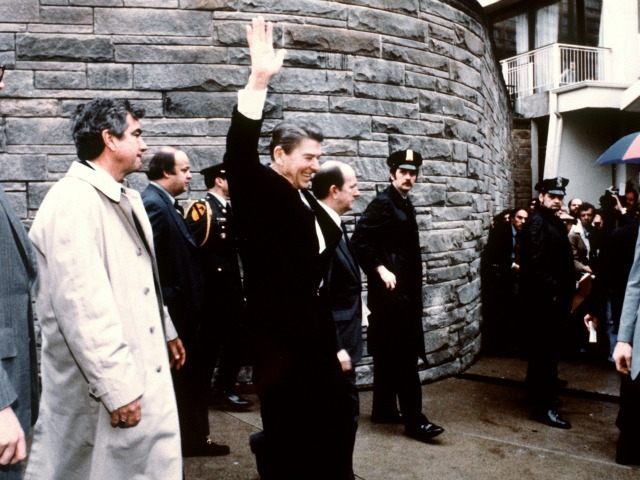In an interview with Breitbart News Executive Chairman Stephen K. Bannon, Fox News host and bestselling author Bill O’Reilly discussed O’Reilly’s new book, Killing Reagan: The Violent Assault that Changed the Presidency. The book focuses on the failed murder attempt by John Hinckley, Jr. on President Ronald Reagan in 1981 in order to impress actress Jodie Foster.
O’Reilly has written a series of books about great historical figures who were killed or assassinated, including Killing Kennedy, Killing Patton, Killing Jesus, and others. Bannon asked O’Reilly why his newest book subject was about a failed assassination attempt instead of an actual murder.
“We don’t disqualify an attempted assassination, especially when it has ramifications that nobody knows about,” O’Reilly said. “We didn’t commit to the book until we researched, and I kept going ‘woah I didn’t know that,’ and I’m a guy that’s pretty locked into this stuff.”
O’Reilly explained how most people know about the actual assassination attempt in which Reagan was shot and made a near miraculous recovery. However, he explained how what happened after the attempted murder of the president is mostly “shrouded in secrecy.”
“This attempted assassination changed the presidency, changed Reagan, changed the country,” O’Reilly said.
Bannon and O’Reilly discussed the immense physical toll the shooting took on Reagan, and how in many ways the country was in the dark about the true condition of the Gipper. While there was no attempt to lie or cover up Reagan’s condition by the administration, according to O’Reilly, they were worried about the president’s recovery and how he “would conduct himself.” This worry was generally not shared with the public.
“Why would you give your enemies abroad and political enemies that kind of advantage? You don’t. So basically, the public did not understand the full trauma that Ronald Reagan experienced,” O’Reilly explained.
Reagan, almost miraculously, tried to overcome the wounds and be effective “in spite of them,” according to O’Reilly. This was the kind of “nobility” and “courage” Reagan had that the Fox News host said he did not quite understand until after writing this book. While O’Reilly said that he always knew that Reagan was a man of principles and intellectual courage, he did not understand the depth of physical courage the 40th president of the United States had exhibited in his recovery.
Bannon then spoke about a visit he and O’Reilly had at the Reagan Ranch in Southern California, and how the Fox News host believes it is important to actually visit historic homes to understand how great figures in history really lived and conducted their lives. O’Reilly remarked about the simplicity of the ranch and how it was not a dwelling of “grandeur” and that “the horses looked better than the people.”
When Bannon asked if O’Reilly was attracted to writing about Reagan because of his humble, middle-class origins, O’Reilly responded:
I’m attracted to guys like Abraham Lincoln, Teddy [Roosevelt], and Ronald Reagan not so much because of their humble… circumstances which I admire, but because they lived robust lives. They really embraced life and were courageous, and that’s what really drew me. But I didn’t really know what Ronald Reagan was like as a person, and this was the real instructive part of the ranch visit.
Pushing back against the charges at the time that Reagan was a “warmonger” and “imperious,” O’Reilly described the ranch as a simple home for such a prominent figure. Gathering first-hand knowledge of the subject is what O’Reilly attributes to the success of his books and the ability to paint the appropriate picture of the time in history.
O’Reilly went on to explain the transformation of Reagan’s wife, Nancy, who went from “striver,” to “diva,” and then finally to “hero,” devoting her life to a declining husband in a “magnificent expression of love.”
What Nancy Reagan went through at the hospital after Reagan got shot was “very much what Jacqueline Kennedy went through,” according to O’Reilly. He said there was a tremendous similarity with how both women reacted in the days following the shootings. In the case of Nancy, she became incredibly protective of her husband when he made it through the ordeal.
Bannon said that O’Reilly’s interpretation of Reagan’s would-be assassin Hinckley is one of the great insights of the book, and that Killing Reagan offer’s a unique perspective. Bannon said that instead of coming out looking like a madman, Hinckley more resembles Lee Harvey Oswald, a left-wing political activist and member of the ACLU who was trained extensively in the use of firearms and assassinated President John F. Kennedy.
Hinckley made multiple attempts to murder American politicians, including Senator Ted Kennedy and President Jimmy Carter, but was unable to pull it off. O’Reilly said both Oswald and Hinckley were “men of rage who overcame their sensibilities that human life matters.” They were not “crazy guys” according to O’Reilly, they were “villains” who knew right from wrong.
Bannon asked O’Reilly about the “Cannon Memo,” which O’Reilly considers the “lynchpin” and most important aspect of his book. The memo was an assessment of Reagan’s second term. O’Reilly calls the memo so “harrowing” and so “important” in defining Reagan, that the “whole book is built around it.”
The memo was written by James Cannon, a friend of Reagan’s, and it postulated that Reagan might not be fit to carry out the duties of the presidency in his second term. However, O’Reilly said that Reagan dramatically “rises” to the occasion and concludes his presidency.
When asked by Bannon about the conservative movement to make America great and stand up for the United States, O’Reilly felt that “Something could change, but I don’t think it’s there yet.”

COMMENTS
Please let us know if you're having issues with commenting.